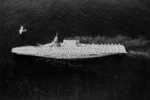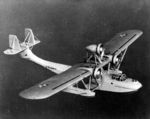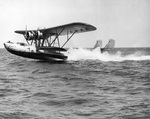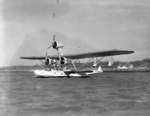P2Y
| Country | United States |
| Manufacturer | Consolidated Aircraft |
| Primary Role | Seaplane |
| Maiden Flight | 10 January 1929 |
Contributor: C. Peter Chen
ww2dbaseConsolidated Aircraft built the prototype Model 9 XPY-1 in 1928 in response to a United States Navy request. In 1931, US Navy issued an order for the new prototype aircraft Model 22 Ranger XP2Y, the design which would become the P2Y-1 flying boats that would enter service by mid-1933. They were parasol monoplanes with fabric-covered wings, and their hulls were made of aluminum. In 1935, the P2Y-2 variant aircraft began entering service. In 1936, at least 21 of the P2Y-1 aircraft were modified to the P2Y-2 specification. Around the time when the United States entered WW2, all P2Y aircraft were withdrawn from front line service and were relocated to Naval Air Station Pensacola and Naval Air Station Jacksonville in Flordia, United States for training missions. About 70 P2Y aircraft of all variant designs were built and sold to the US Navy.
ww2dbaseOne P2Y-1 aircraft, redesignated P2Y-1C, was sold to Colombia in Dec 1932; this aircraft saw combat as a combat during the 1932-1933 Colombia-Peru War. Another P2Y-1 aircraft, redesignated P2Y-1J, was sold to Japan in Jan 1935; this aircraft was designated by the Japanese Navy as Consolidated Navy Experimental Type C Flying Boat and was only used in evaluation flights. Six P2Y-3 aircraft, redesignated P2Y-3A, were sold to Argentina. These 8 examples sold abroad brought the total number built to 78.
ww2dbaseSource: Wikipedia
Last Major Revision: Aug 2014
P2Y Timeline
| 10 Jan 1929 | P2Y aircraft took its first flight, piloted by Lieutenant A. W. Gorton out of Naval Air Station Anacostia in Washington DC, United States. |
| 26 May 1931 | US Navy issued an order for Consolidated Aircraft to build the prototype aircraft Model 22 Ranger XP2Y-1. |
| 7 Jul 1931 | US Navy issued an order from Consolidated Aircraft for 23 P2Y-3 aircraft. |
| 1 Feb 1933 | US Navy squadron VP-10 based at at Norfolk, Virginia, United States received the first delivery of P2Y-1 flying boat. |
SPECIFICATIONS
P2Y-3
| Machinery | two Wright R-1820-90 Cyclone radial engines rated at 750hp each |
| Armament | 1x7.62mm flexible bow M1919 Browning machine gun, 2x7.62mm flexible dorsal M1919 Browning machine guns, 910kg of bombs |
| Crew | 5 |
| Span | 30.48 m |
| Length | 18.82 m |
| Height | 5.82 m |
| Wing Area | 140.65 m² |
| Weight, Empty | 5,792 kg |
| Weight, Loaded | 11,460 kg |
| Speed, Maximum | 240 km/h |
| Speed, Cruising | 189 km/h |
| Rate of Climb | 3.30 m/s |
| Service Ceiling | 4,265 m |
| Range, Normal | 1,899 km |
Photographs
 |  |  |  |
Did you enjoy this article or find this article helpful? If so, please consider supporting us on Patreon. Even $1 per month will go a long way! Thank you. Share this article with your friends: Stay updated with WW2DB: |
Visitor Submitted Comments
All visitor submitted comments are opinions of those making the submissions and do not reflect views of WW2DB.
- » WW2DB's 20th Anniversary (29 Dec 2024)
- » Wreck of USS Edsall Found (14 Nov 2024)
- » Autumn 2024 Fundraiser (7 Nov 2024)
- » Nobel Peace Prize for the Atomic Bomb Survivors Organization (11 Oct 2024)
- » See all news
- » 1,150 biographies
- » 337 events
- » 44,024 timeline entries
- » 1,242 ships
- » 350 aircraft models
- » 207 vehicle models
- » 375 weapon models
- » 123 historical documents
- » 260 facilities
- » 470 book reviews
- » 28,621 photos
- » 431 maps
Lt. Gen. Lewis B. "Chesty" Puller, at Guadalcanal
Please consider supporting us on Patreon. Even $1 a month will go a long way. Thank you!
Or, please support us by purchasing some WW2DB merchandise at TeeSpring, Thank you!
18 Feb 2022 09:44:11 AM
Looking for serial numbers and squadrons for the P2Y-3 aircraft after July, 1931. Also, Looking for the color tail codes attached to each squadron during that period.